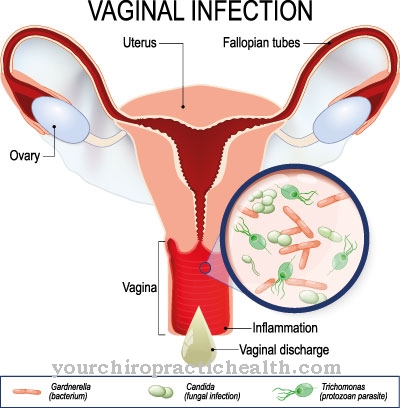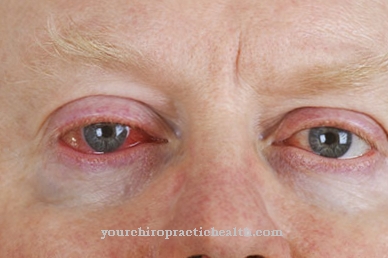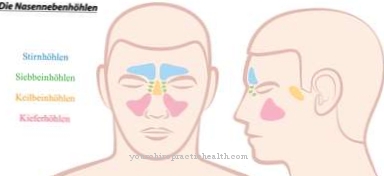In the Congested liver it is liver damage caused by a build-up of blood in the liver. There are acute and chronic courses of the disease. If left untreated, the liver will be completely destroyed in the long term.
What is a congested liver?

A Congested liver is a liver disease caused by the buildup of blood in the liver. This back pressure disrupts their oxygen supply and leads to the destruction of liver cells in the short or long term. The blood backlog is caused by a disturbed outflow of venous blood. Usually right heart failure is present. However, lung diseases and thromboses in the hepatic vein are also possible reasons.
There are three forms of congestive liver. In this way an acute, a subacute and a chronic form can be distinguished. Often there are different reasons for developing these different forms. However, the acute congestive liver can change into the chronic form in the long term. A striking feature of the congested liver is an enlargement of the organ due to the backflow of blood. Only in the chronic form does the liver appear shrunk, although there is also a congestion here. The final state of the congested liver is usually cirrhosis of the liver, which in the case of the congested liver as Cirrhosis cardiaque (cardiac cirrhosis) referred to as.
root cause
The cause of a congested liver is always to be found in the backflow of venous blood in the liver. This backlog can have several reasons. Usually right heart failure is present. The heart is no longer able to pass the venous blood sufficiently into the pulmonary circulation. The backflow of the venous blood begins in the liver and can affect other organs of the dependent organ system. The congestive liver is therefore always a consequence of an underlying disease.
Right heart failure, in turn, can have several causes. Heart valve defects, tumors, embolisms or chronic lung diseases lead to heart failure. Right heart failure describes the weaker performance of the right ventricle. It is responsible for conveying the venous blood into the pulmonary circulation in order to be able to refresh it with oxygen through a gas exchange.
Severe chronic lung diseases such as COPD or pulmonary fibrosis increase the resistance of the pulmonary circulation to the venous blood, so that the cardiac output is overwhelmed in the long term. Chronic congestive liver develops. Pulmonary embolism and sudden occlusion of the liver vein by blood clots represent acute emergency events which, among other things, also show the symptom of congestive liver.
Acute hepatic vein occlusion is also known as Budd-Chiari syndrome. In addition to the sudden development of a blood clot, a tumor that presses on the hepatic vein can also be responsible for the occlusion of the hepatic vein. After the accumulation of blood in the liver tissue, there is initially an insufficient supply of the liver cells surrounding the central veins. The metabolism is disturbed and the hepatocytes begin to become fatty. If the jam persists for a long time, necrosis of the affected liver cells begins.
Symptoms, ailments & signs
Initially, the symptoms of a congestive liver manifest themselves as discrete symptoms of the underlying disease. This is followed by the classic signs of hepatic insufficiency, which show up in the occurrence of jaundice (jaundice), coagulation disorders and hepatic coma. The course of the disease, however, varies dramatically and depends on whether it is the acute, subacute or chronic form of the congestive liver.
If left untreated, a congested liver ends in the complete destruction of the liver tissue. The acute congestive liver shows a dramatic course. The liver swells very quickly, with acute pain in the liver capsule. The liver is spontaneously very painful when touched. Macroscopically, it appears enlarged with a dark red surface. At the same time, small red dots appear. In the subacute form, the liver looks enlarged and blotchy.
This look is also known as the fall foliage pattern. In addition to red spots, white spots also appear. The reddish spots characterize the enlarged sinusoids (small blood vessels), while the white spots represent fatty liver parenchyma. At this stage, liver necrosis begins.
In the chronic form of congestive liver, the liver appears smaller again, although it should be enlarged as expected. However, connective tissue forms in the area of the dead liver tissue. The liver shrinks and hardens. This leads to cirrhosis of the liver.
Diagnosis & course of disease
Ultrasound examinations are performed to diagnose congestive liver. A greatly enlarged organ with enlarged liver veins is found. While acute congestive liver appears to be less echoic than in the normal state, in the chronic form of the disease there are condensed, fine-humped echo structures.
In the extensive laboratory tests, the values of transaminases, gamma-glutamyltransferase (GGT) and various other values are of interest. Elevations in these laboratory values indicate abnormal liver function. The relationship between these laboratory values is of interest for the differential diagnosis to other liver diseases.
Complications
A congested liver usually develops as a result of a right heart failure (right heart failure), which has various complications. The consequences of untreated right heart failure are cardiac arrhythmias. With atrial fibrillation, thrombi can easily form in the wall of the atrium, which can then loosen and continue to be carried away with the bloodstream.
In the case of the right heart, the blood clots are carried towards the pulmonary vessels and can cause a pulmonary embolism, which is characterized by shortness of breath and devastating chest pain. If left untreated, ventricular fibrillation can quickly lead to cardiac arrest and consequently to immediate cardiac death. The congestion of the blood in the liver leads to an enlargement of the organ, which can cause pain in the right upper abdomen.
In addition, cirrhosis of the liver can develop over time. In this case, the liver is no longer able to synthesize enough proteins and edema and coagulation disorders as well as ascites occur. Even the blood can no longer be transported properly through the liver, so that it has to be diverted to the spleen.
As a result, the spleen enlarges (splenomegaly) and further pain occurs. Further immediate circulation results in esophageal varices and hemorrhoids. In addition, the detoxification function is no longer guaranteed in cirrhosis of the liver; more ammonia accumulates in the blood, which can lead to encephalopathy.
When should you go to the doctor?
Because the liver does not have its own pain receptors, a doctor should be consulted if there is diffuse pain in the right upper abdomen. This pain only arises when the organ is already enlarged. Increasing tiredness and exhaustion can often be an alarm signal for acute, subacute or chronic congestive liver disease. Even if the liver reacts to pressure with spontaneous pain, the decision to see a doctor is very obvious.
Because right heart failure can also lead to congestive liver, an internist or cardiologist should be consulted directly if there is heart pain. This is particularly important if there is an arrhythmia (abnormal heart rhythm). Shortness of breath combined with cardiac involvement can indicate that blood clots are being transported to the pulmonary vessels. If so, medical treatment must be initiated immediately.
Anyone who observes yellowing of the skin or mucous membranes should inform their doctor immediately. If, over time, coagulation disorders or symptoms of jaundice become apparent, seek medical advice immediately.
Therapy & Treatment
Since the congested liver is not an independent disease, but always the consequence of an underlying disorder, the underlying disease must be treated in order to cure it. Mostly it is a right heart failure, the cause of which has yet to be determined.
It should be noted that the drug metabolism may be disturbed due to the liver disease. This often requires other treatment strategies in addition to drug treatments. In rare cases, surgical measures such as heart or lung operations are also effective.
Outlook & forecast
A congested liver is a severe symptom of a liver disease, which is why the prognosis is usually negative. Usually, the underlying disease leads to further complaints, which further strain the liver and ultimately lead to organ failure.
When congested liver occurs, treatment of the mostly causative liver cirrhosis is usually no longer possible. The inevitable liver failure can, however, be delayed; how long depends on the type and severity of the underlying illness, the constitution of the patient and possible previous illnesses.
The prospect of liver cirrhosis is determined with the help of the Child-Pugh criteria, which take into account liver function (blood coagulation, bilirubin level, etc.) and possible secondary diseases (ascites, encephalopathy) and on the basis of this allow a precise prognosis. The chances of recovery from causal ascites are around 50%, with further inflammation making a very severe course more likely.
The prospect of congestive liver disease is also made worse by possible complications such as bleeding or by the formation of cysts and tumors in the liver.The final prognosis should always be made by a doctor.
prevention
To prevent congestive liver, all recommendations apply that are also made to avoid cardiovascular and lung diseases. A healthy lifestyle with a balanced diet, plenty of exercise and refraining from smoking or alcohol reduce the risk of congestive liver disease.
Aftercare
With congested liver, in most cases, those affected have only limited direct follow-up measures available, so that those affected should ideally see a doctor at the first signs and symptoms of this disease. No independent healing can occur, so that a doctor should be consulted at an early stage. As a rule, an early diagnosis of this disease always has a very positive effect on the further course.
As a rule, the underlying disease must be treated correctly in congestive liver so that there are no further complications and complaints. In many cases, surgery is necessary. After that, the person concerned should definitely rest and take it easy.
Physical exertion or stressful activities should be avoided in any case in order not to unnecessarily burden the body. Regular checks by a doctor are also very important after the procedure. In general, a healthy lifestyle with a balanced diet can have a positive effect on the further course of the disease in the case of congestive liver.
You can do that yourself
Because a congested liver is not caused by an independent reason, the person affected should take measures for the general treatment of the underlying disease. The corresponding steps depend on the specific disease.
In principle, the same recommendations apply to the prevention of congestive liver disease as are given for the prevention of cardiovascular and lung diseases. A healthy lifestyle is recommended for those affected. This includes a healthy and balanced diet. Above all, there are plenty of fresh fruit and vegetables available here, and excessive consumption of fast food and finished products should be avoided. Lots of exercise and adequate sleep can also reduce the risk of congestive liver disease. The consumption of nicotine, alcohol or drugs should be avoided in the sense of prevention.
In addition, those affected should undergo preventive examinations at regular intervals and consult a doctor immediately if the first symptoms appear. Avoiding stress also has a positive effect. If the patient is exposed to a high degree of stress, relaxation-promoting measures such as long walks, yoga or various meditation techniques are available.



























